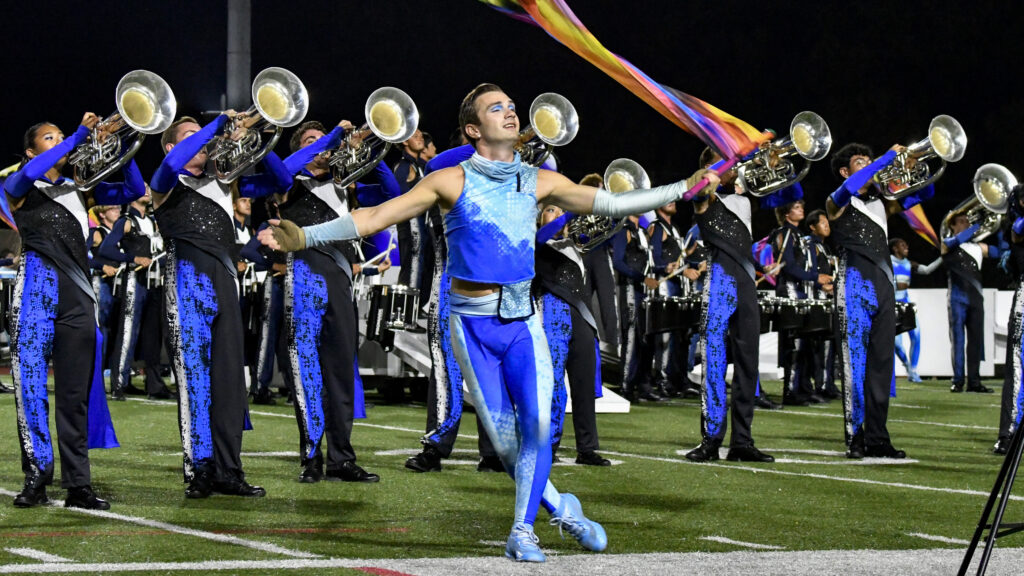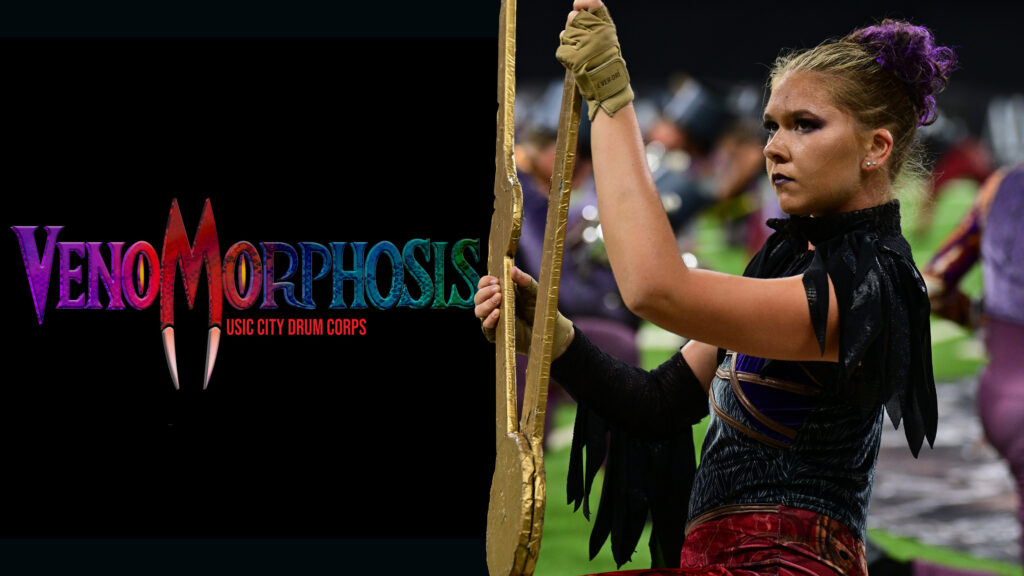
It’s the time of year for festive lights, merry music, and great shopping deals in stores and online. As you get set to celebrate another holiday season, you might be surprised to find that sounds of the Christmas season have long been heard as part of drum corps’ competitive productions.
The following selections are some of the favorites that have graced the football field at the DCI World Championship Finals. Whether the works are of a symphonic or popular nature, they’ve all put smiles on the faces of drum corps fans, perhaps stirring up fond memories of wintry holidays of a different place and time, even if performed in June, July and August.
1. 2012 Cadets
“12.25,” a production by the Cadets that put holiday earworms in drum corps fans all summer long, concluded with “Angels We Have Heard on High.” The song is inspired by the story in the Gospel of Luke that spoke of shepherds outside of Bethlehem hearing angels singing about the birth of the Christ child.
The words of the hymn are based on an ancient French carol, with the music we know today set to “Gloria” by Edward Shippen Barnes, an American organist who perhaps discovered the words when studying in France in the early 1900s. The closing tag of the show included short snippets from “Good King Wenceslas,” “Adeste Fideles (O Come All Ye Faithful),” and “Joy to the World.”
2. 1987 Santa Clara Vanguard & 1978 Crossmen
“Russian Christmas Music” was written by Alfred Reed in 1944 and became not only his most famous work but also one of the most played works for concert band. Amazingly, Reed wrote the score and parts in just 16 days, back when everything had to be done by hand. The one-movement work is divided into four sections, ending with “Cathedral Chorus,” the snippet in the accompanying video.
Santa Clara Vanguard’s version came from the opener of its costumed spectacular, which was just a tenth of a point away from winning the World Championship title. Crossmen’s rendition is from the climax of its production; the second of five times the corps has performed the work.
3. 1987 Phantom Regiment
4. 1975 Royal Crusaders
“The Hallelujah Chorus” is one of the best-known musical selections from the Baroque period. Written by Georg Frederick Handel in 1741, it was originally conceived to conclude the second part of his three-part oratorio, “The Messiah.” However, the selection soon took on a life of its own and is often performed separate from the rest of the oratorio, most often at Christmastime.
Legend has it that British monarch King George II stood when the piece was played during the London premiere, a tradition that remains to this day in churches and concert halls.
5. 1991 Cavaliers
Barber based the melody of “Die Natali” on the popular Christmas carol, “Silent Night,” composed in 1818 by Austrian composer and primary school teacher Franz Gruber. The Cavaliers’ performance of the piece during “The Cavalier Anthems: The Advent Collection” is remembered for the use of giant windsocks that started out as metallic blue and were then inverted to become shiny silver.
6. 1979 Guardsmen
7. 1975 Kilties
Although “Auld Lang Syne” isn’t considered a Christmas tune, it’s often heard on New Years Eve, the seventh day of the 12 days of Christmas. The Scottish folk song tune is based on a Robert Burns poem of 1788, the title loosely translated as “so long ago.” It was sung in the British Isles during New Years centuries before Guy Lombardo popularized it in America, performing it at the stroke of midnight during his annual New Year’s Eve radio and television broadcasts.
The melody was first performed by the Kilties in 1960 and showed up in the corps’ productions 16 times throughout its history. There are few tunes as closely associated with a single corps.
8. 1993 Colts
“Do You Hear What I Hear?” is the newest Christmas carol on this list of DCI favorites, written in 1962 by the husband and wife team of No?«l Regney and Gloria Shayne Baker. The couple wrote the piece in reaction to the Cuban Missile Crisis, which brought fear of nuclear annihilation to the Americas. It was recorded by the Harry Simeone Chorale, which in 1958 also brought “The Little Drummer Boy” to greater prominence. Bing Crosby launched the song way up the hit charts with his recording of 1963.
Colts played the melody as part of the “Winter” medley that served as the corps’ opener during its “Iowa’s Four Seasons” production. The show earned the Colts a spot among the top 12 corps at the DCI World Championship Finals for the very first time.
9. 2003 Carolina Crown
“Carol of the Bells” was written in 1904 by Ukrainian composer Mykola Leontovych and introduced to America in 1921 through a Carnegie Hall performance and subsequent national tour by the Ukrainian National Chorus. It was originally written to be performed by a four-part a cappella choir.
Carolina Crown performed the piece during the closer of the corps’ “Bell-issimo” show, a production that focused on how bells have been utilized for centuries to announce both joyful celebrations and times of reverence.
10. 1991 Freelancers
The 16-movement “Hodie,” finished in 1954, was British composer Ralph Vaughan Williams’ final large-scale composition for orchestra and chorus. The cantata began with the jubilant Latin text, “Nowell! Nowell! Nowell!,” which in English translates to “Christmas! Christmas! Christmas!”
Freelancers commenced their 1991 show with the “Prologue” segment that began with a brassy fanfare and then went into the three “Nowells” referenced above. The show was the first of two consecutive finalist productions by the corps of primarily symphonic literature.
11. 1976 Bridgemen
A farandole is a form of dance from southeast France in which dancers hold hands while moving around a circle. “Farandole” is among the best-loved works of Georges Bizet. Composed in 1872 for a play, the work didn’t attract much attention until one of Bizet’s friends arranged it into “L’Arlesienne Suite No. 2” four years after the composer’s death.
The work served as the second percussion feature in the show that turned the Bridgemen into the corps everyone remembers today. In 1976, program and drill designer Bobby Hoffman came to the group and introduced long yellow uniform jackets and a healthy dose of humor into the corps’ programming.
12. 1996 Bluecoats
Hugh Martin and Ralph Blane wrote “Have Yourself a Merry Little Christmas” for the 1944 MGM musical, “Meet Me in St. Louis,” a movie about local residents living in St. Louis prior to the city’s hosting of the 1904 World’s Fair. Judy Garland sang the song in the movie, but only after lyricist Martin rewrote the lyrics to make the song cheerier than it was originally conceived.
The song served as the Christmas segment of Bluecoats’ 1996 production, “American Celebrations,” which also included segments representing Valentine’s Day, the Fourth of July, and New Years.
Holiday sales at DCIstore.org

Don’t miss out on shipping discounts and other deals on Drum Corps International’s extensive archive of audio/video titles from the DCI World Championships this holiday season. Select performances from 1974 all the way to the present day are available.





